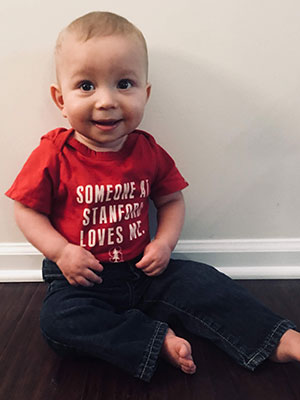A Rare Pulmonary Defect Prompts Parents’ Nationwide Search for Answers
After hearing that their baby was not a candidate for a life-saving surgery, they scoured the internet for help that led them to Lucile Packard Children’s Hospital Stanford.
For release: April 24, 2019

PALO ALTO, Calif. – When Carter Johnson came into the world on January 9, 2018, he was perfect in every way, according to his parents, Kelly and Malcolm. But their joy was short-lived and replaced with worry and fear.
Something wasn't quite right. Carter's color was off and he was turning grey, prompting the care team at the local hospital in the Baltimore—Washington Metro area to whisk him to the neonatal intensive care unit (NICU) for tests. When that failed to provide answers, the family was sent to a regional hospital for further examination. That's where they discovered there was no blood flow into Carter's right lung. He was diagnosed with a rare condition called absent right pulmonary artery.
Time was of the essence. Typically, this condition is associated with multiple congenital heart defects, prompting additional echocardiograms, more tests and a rapid search for answers. In Carter's case, his doctors in Maryland determined that the uncommon malformation was isolated. But risks were high, as Carter’s test results revealed pulmonary hypertension and other complications could be imminent. Carter needed help.
Searching for the best treatment
Kelly and Malcolm were told by the regional hospital that the best course of treatment for Carter’s condition was surgery but that he was not a candidate because, as Malcolm describes, “Carter had some decent-sized collateral arteries but they couldn’t make a successful connection in the lung. It turns out, one of those collaterals was actually Carter’s pulmonary artery that had never fully formed or connected.”
Malcolm went into research mode and delved into pages of medical journals. He also sought second and third opinions from some of the nation's leading children's hospitals. All the results of his research pointed to the same treatment plan of placing a shunt to initiate blood flow to the right lung. This plan would require repeat surgeries throughout Carter’s life to up-size the shunt as he grew. Malcolm wasn’t satisfied with that.
"I'm stubborn by nature," he laughed. "I just felt there was something else for Carter."
One night, on his laptop he came across the Pulmonary Artery Reconstruction (PAR) program at Lucile Packard Children’s Hospital Stanford. He shook Kelly awake and told her, “I think I found it.”
The next day, Kelly and Malcolm were on the phone with Jennifer Shek, a nurse practitioner in the cardiothoracic surgery department at Stanford Medicine Children's Health. She told them Carter was a promising candidate for the PAR program. The team—led by Division Chief of Pediatric Cardiac Surgery Frank Hanley, MD, and Director of the Pulmonary Artery Reconstruction Program Doff McElhinney, MD—is rated as a top cardiology and heart surgery program in U.S. News & World Report and has been recognized worldwide for using innovative approaches for surgical management of complex pulmonary artery procedures.
After the team at Stanford reviewed Carter’s cardiac catheterization and angiography tests, they saw that Carter did in fact have a pulmonary artery, but it originated from the wrong place. The doctors diagnosed Carter with discontinuous pulmonary artery resulting from a ductal origin, the condition is also sometimes called absent pulmonary artery. A unique surgical approach to Carter's case would restore his lung without requiring any long-term treatments.
“We could hardly believe our ears,” said Kelly.
According to McElhinney, the Stanford Children’s team’s unique experience and expertise with complex pulmonary artery reconstruction surgery and management was the expert care that the Johnsons needed to get the best result for Carter.
“We perform 2-3 complex pulmonary artery repair and reconstruction procedures every week on patients from all over the world,” said McElhinney. “The strategies and techniques pioneered by Dr. Hanley, and also practiced by his surgical partner Michael Ma, MD, allow thorough and complete enlargement of pulmonary artery branches not only outside of the lung but with the lung as well, which is unique and allows the most effective treatment of these conditions.”
Exceeding all expectations
Carter underwent two surgeries in 2018 to repair his heart. His first surgery in June implanted a shunt that established blood flow to his right lung, which doctors expected would allow his pulmonary artery to grow naturally. Five months later in November 2018, Hanley and his team performed the definitive pulmonary artery reconstruction, in which they removed the shunt and connected the grown pulmonary artery. During the five months between the two surgeries, Carter’s pulmonary artery grew to normal size – surpassing the doctors’ expectations.
Today, Carter is back home in Maryland and doing well. His hometown medical care team—from his pediatrician to his cardiologist—have communicated frequently with the Stanford team to ensure fully coordinated care, coast to coast.
"Dr. Hanley and his team have delivered on their promise that Carter will live a normal life," said Kelly. Dr. Hanley told her and Malcolm that Carter will be repaired; “he will run, play baseball and have no restrictions. As parents, that was our greatest hope.”
Media contact:
Kate DeTrempe
kdetrempe@stanfordchildrens.org
(650) 721-8527
About Stanford Medicine Children's Health
Stanford Medicine Children’s Health, with Lucile Packard Children’s Hospital Stanford at its center, is the Bay Area’s largest health care system exclusively dedicated to children and expectant mothers. Our network of care includes more than 65 locations across Northern California and more than 85 locations in the U.S. Western region. Along with Stanford Health Care and the Stanford School of Medicine, we are part of Stanford Medicine, an ecosystem harnessing the potential of biomedicine through collaborative research, education, and clinical care to improve health outcomes around the world. We are a nonprofit organization committed to supporting the community through meaningful outreach programs and services and providing necessary medical care to families, regardless of their ability to pay. Discover more at stanfordchildrens.org.
Connect with us:
Download our App: